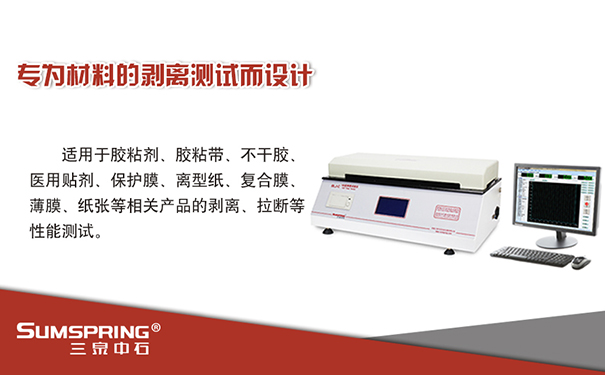How to detect the peel strength of the plaster?
Source: Sanquan Zhongshi Headquarters Editor: Sanquan Zhongshi News Department August 15, 2017
How to detect the peel strength of the plaster? The problem of how to detect the peel strength of a plaster using the 180° peel tester BLJ-C is explained in detail herein. The 180° peel tester BLJ-C has two test modes: spot peel strength and peel strength test. Professionally applied to the peel strength test of various pastes. It is an ideal choice for the production of gel pastes, rubber pastes, babu pastes, cataplasms, and plasters.
Key words: 180° peeling test machine, cataplasm 180° peeling test machine, gel paste 180° peeling test machine, rubber paste 180° peeling test machine, Babu paste 180° peeling test machine, plaster 180° peeling test machine
In the course of use, the plaster needs to adhere to a certain part of the human body for a long time, and after a period of use, the patch should be replaced according to the doctor's request, so as to better restore the affected part. People often encounter the feeling of discomfort when they use the plaster. Some adhesives are too strong to cause pain, so the manufacturer is also very concerned about this performance. In the industry, this property is called peel strength. How to detect the peel strength of the plaster? There is also a clear regulation in the 2015 edition of the National Pharmacopoeia Adhesion Test.

180° peel tester
The 180° peeling tester BLJ-C produced by Jinan Sanquan Zhongshi Experimental Instrument Co., Ltd. is developed according to the requirements of the 2015 and YY/T0148 standards of the People's Republic of China for adhesives, adhesive tapes, stickers, medical patches, An instrument for testing performance such as peeling and breaking of protective films, release papers, composite films, films, papers, and the like. The 180° peel tester BLJ-C has two test modes: spot peel strength and peel strength test.
How to detect the peel strength of the plaster with the 180° peeling test machine BLJ-C, the following small series will give you a detailed introduction to the specific steps:
Preparation before the test begins:
First clean the test board: scrub the test board with a wiping cloth and wipe it thoroughly, then wipe it dry with a clean gauze and repeat it several times until the working surface of the test board is clean. After wiping clean, do not touch the working surface of the board with your hands or other objects.
Then take the sample and sample preparation: Take a clean plaster of 200mm or more, the adhesive surface of the plaster should not touch the hand or other substances. The plaster is bonded to the cleaned test panel. Then, the sample was rolled back and forth three times at a speed of about 300 mm/min under a self-weight by a pressure roller (no air bubbles were allowed to exist at the adhesion of the sample to the test plate). After the sample is prepared, it should be tested after being parked for 20-40 minutes in the test environment.
Specific test steps:
1. Turn on the power, turn on the power switch, enter the welcome screen, wait 20 seconds or press [Reset] to enter the test interface;
2. Press the [Return] key to return the fixture to the initial position, and press the [Set] key to enter the parameter setting interface.
3. Press the [Select] key to select the item to be modified, set the test parameters to the test request value, press [OK] to save after each setting is completed; press [Reset] to return to the test interface;
4. Fold the free end of the sample 180° and peel the adhesive surface from the test plate by about 25 mm. Fix the free end of the sample and the test plate on the fixture respectively, so that the peeling surface is consistent with the test machine force line;
5. Press [Clear] to clear the parameter and press [Test] to start the test.
6. After the test is completed, press [OK] to print out the test results.
Summary: These test steps, explained to you by Xiaobian, can easily solve the problem of how to detect the peel strength of a plaster. The 180° peel tester BLJ-C designed and developed by Jinan Sanquan Zhongshi Experimental Instrument Co., Ltd. adopts a horizontal structure, which can solve the problem that the sensor value is not affected by the weight of the clamp. And equipped with a printer, can quickly output data, convenient for users to save data. It is an ideal choice for the production of gel pastes, rubber pastes, babu pastes, cataplasms, and plasters.
Introduction:
The bulb of garlic,an allium plant in the lily family.with the pungent flavor and spicy taste.spherical shape with a diameter of 3-6.5cm. The surface is covered with white and papery-skin.
The top is slightly pointed, with residual scape in the middle,many fibrous root marks at the base. After peeling off the skin, a single head or 6 to 16 petal-shaped small bulbs, inserted around the base of the remaining flower stems. The bulbous valve is slightly ovoid, with a membranous outer skin, slightly pointed at the apex, and an arcuate bulge on one side.
In order to ensure the maximum freshness and nutrients.
We adhere to the traditional natural drying method without any human intervention.
Selected from new harvesting purple Red Garlic that planted in our organic garlic farm,abandon black spots,decay, pests,rot cloves.
Can be stored for long time under proper conditions after sun drying.
With the characteristics of big size,white&distinct appearance,pure flavor,pure flavor,crispy taste,high capsaicin.
Specification
Brand:Changrong
Variety:Liliaceous Vegetables
Color:Purple red
Normal Red Garlic,Garlic Cultivars,Dehydrated Normal Red Garlic,Organic Normal Red Garlic
shandong changrong international trade co.,ltd. , https://www.changronggarliccn.com